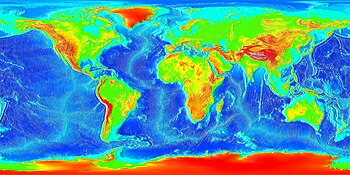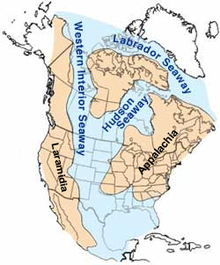
Back Kontinentale plat Afrikaans Plataforma continental AN رف قاري Arabic Plataforma continental AST Şelf Azerbaijani Шэльф Byelorussian Шэльф BE-X-OLD Континентален шелф Bulgarian महादीपी शेल्फ Bihari Plateiz kevandirel Breton


A continental shelf is the part of the continent that is under water. The shelf was part of the land during the ice ages in the glacial periods, but under water in the interglacial periods. We are at present in an interglacial period.[1][2]
Every continent is in the sea, like an island. Most of the island is above the water line, and we see it as a continent. Some of it though, is below the water line. Beyond the continental shelf, the bottom goes down to much greater depths.

The continental shelf is a shallow ocean. It varies in depth, up to 140 metres deep. It varies greatly in its width. At the leading edge of a moving continental plate there will be little or no shelf. The western edge of the Americas are an example. The shelf on a passive edge of a plate will be wide and shallow. The widest shelf is the Siberian shelf in the Arctic Ocean: it is 1500 km (930 miles) in width.
- ↑ Gross, Grant M. 1972. Oceanography: a view of the Earth. Prentice-Hall, Englewood Cliffs N.J. ISBN 0-13-629659-9
- ↑ Pinet, Paul R. 1996. Invitation to oceanography. 3rd ed, West, St Paul, MN. ISBN 0-7637-2136-0
© MMXXIII Rich X Search. We shall prevail. All rights reserved. Rich X Search